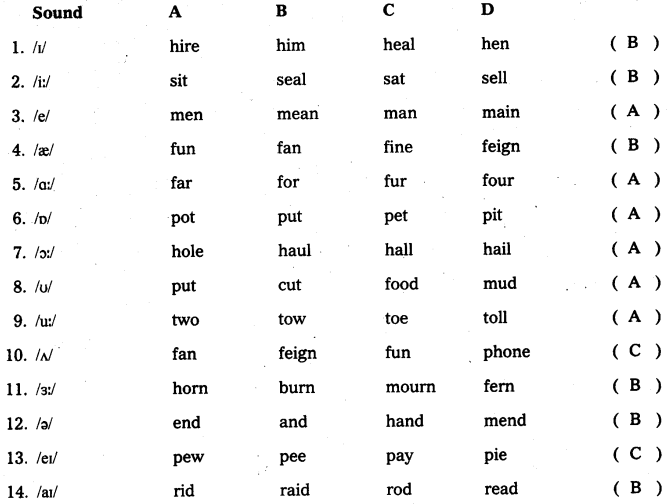Andhra Pradesh BIEAP AP Inter 1st Year English Study Material Communication Skills Introduction to Consonant and Vowel Sounds Questions and Answers.
AP Inter 1st Year English Communication Skills Introduction to Consonant and Vowel Sounds
Constant Sounds
Language has a very important social purpose. It is the most powerful means of communication. It can be used in two ways for the purpose of communication. One is speech form and the other is written form. In every day situation we use more speech form rather than written form. For effective communication in speech form we need correct pronunciation and intonation. In the written form we need correct spelling and punctuation. We use 26 letters of alphabet for written form, among them 21 consonant letters and 5 vowel letters. But for speech form we use 44 sounds. These 44 sounds are divided into 20 vowel sounds and 24 consonant sounds. Phonetics describes these sounds using the symbols of the International Phonetic Alphabet (IPA). The IPA uses a single symbol to describe each sound in a language.
24 English Consonant Symbols
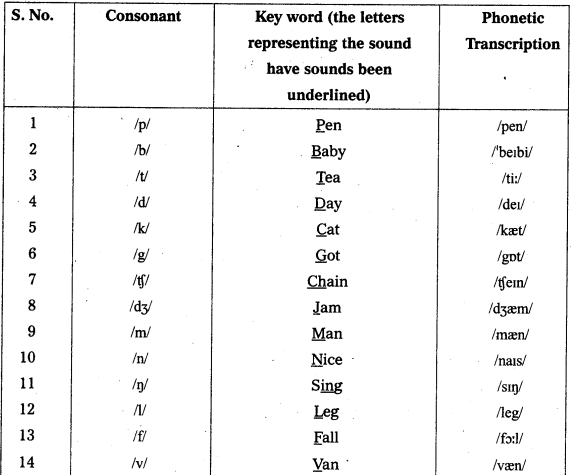
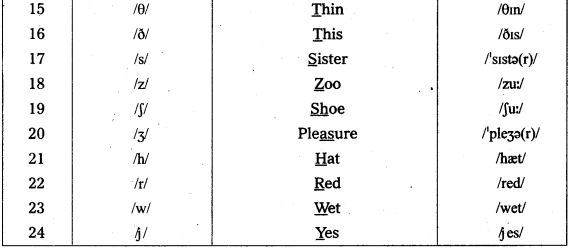
Task: 1
Write the Phonetic Transcription for the following words with the help of a standard dictionary.
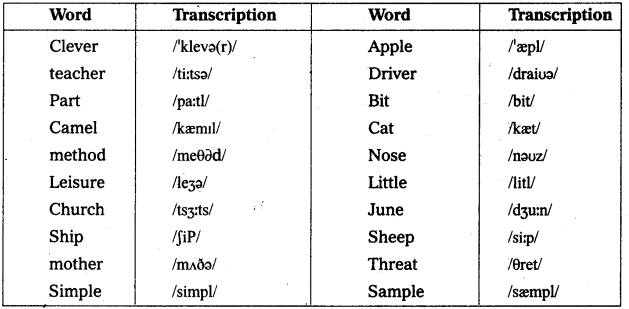
Task: 2
Change the phonetic transcription into orthographic (English spelling)
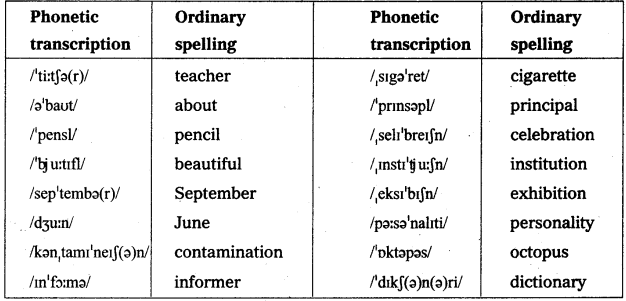
Exercise 1
Write the following transcription in ordinary spelling.
1. /’æmpjuteıt/ – amputate
2. /vestıdʒ/ – vestige
3. /ə’fɔ:dəbl/ – affordable
4. /i:s’θetık/ – aesthetic
5. /1mə’veıʃn/ – innovation
6. /1edʒu’keıʃn/ – education
7. /lə’dʒıstıks/ – logistics
8. /’kærəktə(r) – character
9. /’ɔ:də(r) – order
10. /’mædʒıstreıt/ – magistrate
11. /ə’brɔ:d/ – abroad
12. /’sıtızn/ – citizen
13. /kən’sent/ – consent
14. /’pɜ:pəs/ – purpose
15. /mə’kænık/ – mechanic
16. /1kɒnsn’treıʃn/- concentration
17. /’eləkwənt/ – eloquent
18. /ə’kleım/ – acclaim
19. /kən’si:v/ – conceive
20. /’sıvl/ – civil
21. /tʃa:ns/ – chance
22. /trə’dıʃn/ – tradition
23. /dri:m/ – dream
24. /braıt/ – bright
25. /’ʃædəυ/ – shadow
26./da:k/ – dark
27. /vænəti/ – vanity
28. /daı’næmık/ – dynamic
29. /i’mıʃn/ – emission
30./ha:məni/ – harmony
31. /’mæŋgld/ – mangled
![]()
32. /kɒŋkə(r)/ – conquer
33. /deındʒərəs/ – dangerous
34. /1edʒu’keıʃn – education
35. /hı’stɒrıkl/ – historical
36./1pɒpju’leıʃn/ – population
37. /fıə(r)/ – fear
38. /’hj u:mən/ – human
39. /blʌd/ – blood
40. /’stju:dnt/ – student
41. /ımpɔ:tnt/ – important
42. /’li:dəʃıp/ – leadership
43. /’dıfıkəlti/ – difficulty
44. /hæpinəs/ – happiness
45. /’fi:lıŋ/ – feeling
46. /’nplıdʒ/ – knowledge
47. /sə’saıəti/ – society
48. /’ʃeltə(r)/ – shelter
49. /’mɒdn/ – modern
50. /’məυaıl/ – mobile
51. /’dıdʒıtl/ – digital
52. /ə’gri:mənt/ – agreement
53. /æksıdənt/ – accident
54. /ın’rıtʃ/ – enrich
55. /’neʃbə(r)/ – neighbour
56. /tʃaıld/ – child
57. 1ınfə’meıʃn/ – information
58. /’kʌstəmə(r)/ – customer
59./fa:ðə(r)/ – father
60. /’medsn/ – medicine
Task: 3
What is the definition of a silent letter ?
A silent letter is left unpronounced, such as the d in handkerchief, the n in autumn and the p in cupboard. When talking fast, silent words like t are very lightly pronounced in words like Christmas, mountain and little.
Read the following words loudly and find out the silent consonant letters and underline them.

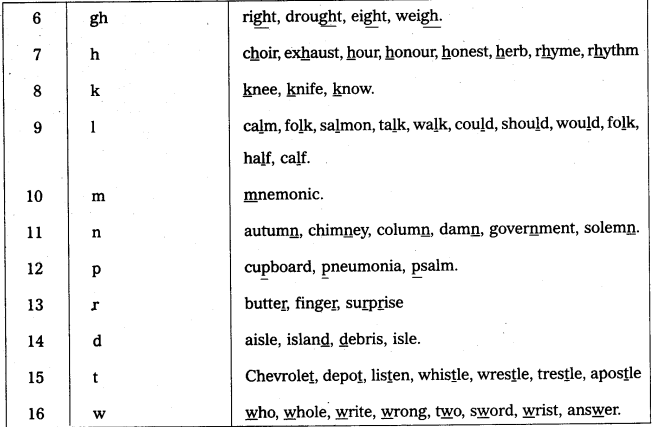
Task: 4
Match the following:
I.
| A | B | |
| 1 | /kʌrıdʒ/ | a. mother |
| 2 | /tɔ:k/ | b. leader |
| 3 | /hæpi/ | c. courage |
| 4 | /’mʌðə(r) | d. talk |
| 5 | ‘lidə(r) | e. happy |
Answer:
1) c
2) d
3) e
4) a
5) b
![]()
II
| A | B | |
| 1 | /ɔ:də(r)/ | a. people |
| 2 | /’mædʒ.ı.streıt/ | b. purpose |
| 3 | /’pɜ:pəs/ | c. order |
| 4 | /ti:tʃə(r) | d. magistrate |
| 5 | /’pi:pl/ | e. teacher |
Answer:
1) c
2) d
3) b
4) e
5) a
III.
| A | B | |
| 1 | /sku:/ | a. tragedy |
| 2 | /әd’ventʃә(r)/ | b. faith |
| 3 | /’trædʒədi/ | c. enjoy |
| 4 | /feıθ/ | d. school |
| 5 | /in’dʒɔɪ/ | e. adventure |
Answer:
1) d
2) d
3) a
4) b
5) c
IV.
| A | B | |
| 1 | /tek’nɒlədʒi/ | a. skill |
| 2 | /skıl/ | b. affordable |
| 3 | /əfɔ:dəbl/ | c. success |
| 4 | /hju:mən/ | d. human |
| 5 | /sək’ses/ | e. technology |
Answers:
1) e
2) a
3) b
4) d
5) c
V.
| A | B | |
| 1 | /saıklıst/ | a. resilience |
| 2 | /rı’zıliəns/ | b. dream |
| 3 | /’hɒspıtl/ | c. hospital |
| 4 | /dri:m/ | d. cyclist |
| 5 | ‘maυntən | e. mountain |
Answers:
1) d
2) a
3) c
4) b
5) e
![]()
VI.
| A | B | |
| 1 | /’nɒvlti / | a. university |
| 2 | /frend/ | b. ethnic |
| 3 | /ju:nı’v3:səti/ | c. friend |
| 4 | /’eθnık/ | d. nation |
| 5 | /neıʃn/ | e. novelty |
Answers:
1) e
2) c
3) a
4) b
5) d
Different Sounds: Find the odd one out
Look at the following groups of words. In each group there are three words which have the same consonant but one word is quite different in sound/pronunciation.
Word with odd sound

Exercise 1
Find the word in the group which does not have a homophone to the sound of the underlined letters.
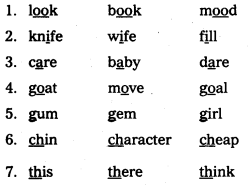
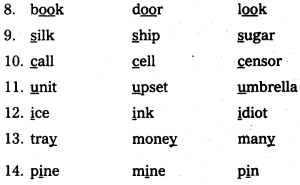
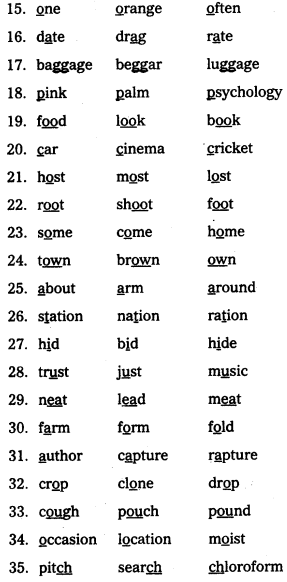
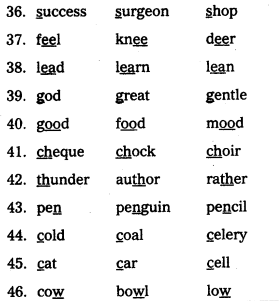




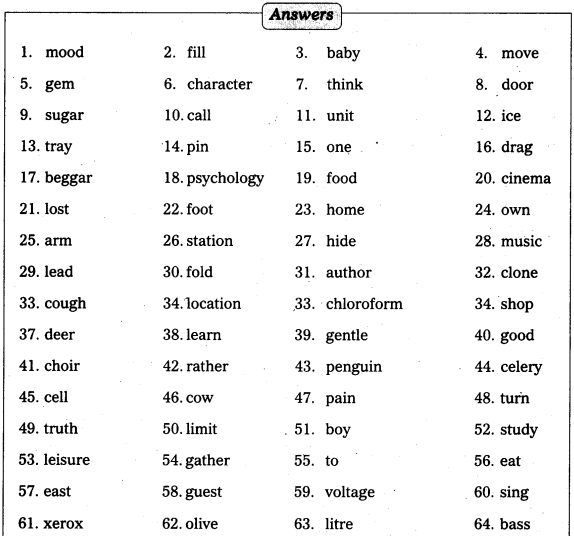
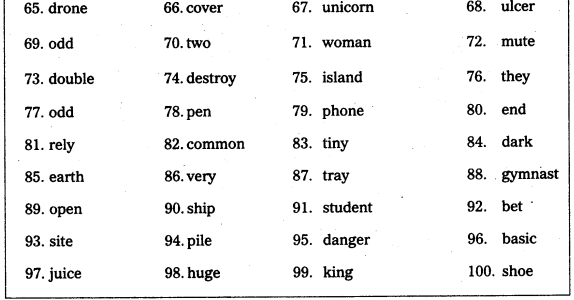
![]()
Vowel Sounds
One of the most difficult areas of English Language is its pronunciation. The letters in English unlike in Telugu do not always carry one definite sound. When we pronounce it in one way, the standard pronunciation shows the other.
Languages are two types. They are Phonetic and Non-phonetic Languages. In Phonetic Languages, the letter and the sound have one to one relationship. In other word, one letter represents only one sound. As such, the number of letters and sounds in phonetic language are the same. E.g. Telugu, Hindi etc. Non-Phonetic languages are those where there is no corresponding relationship between letter and sound. Here the number of letters may be less than the sounds existing in the language. For instance, English has 26 letters where the sounds are 44. As such, each letter is supposed to carry more than one sound, e.g. ‘gadget’ is pronounced as /gæxʒ.ıt/. The ‘g’ in the first place is pronounced as /g/ whereas the ‘g’ in the fourth place is pronounced as /dʒ/. The IPA, or International Phonetic Alphabet is devised to represent each single sound with a specific symbol.

Vowels are those sounds during the pronunciation of which, the mouth passage is unobstructed. There are 20 vowel sounds, and they can be classified into 12 pure vowels and 8 diphthongs. A diphthong is a sound formed by the combination of two vowels in which the sound begins at one vowel and moves towards another (as in coin, loud, and side). To classify the vowel sounds we have to describe them in the following way.
Position of Tongue
Vowels can be classified into three categories taking into account the part of the tongue raised. Thus vowels can be ’front’, ‘back’ or ‘central’.
Three Term Labels : Vowels
1) /i:/ – front, close, unrounded
2) /ɪ/ – centralized front, just above half-close, rounded
3) /e/ – front, between half close and half open, unrounded
4) /æ/ – front, just below the half-open, unrounded
5) /a:/ – back, open, unrounded.
6) /ɒ/back, just above open, rounded.
7) /ɔ:/ – back, between half-open and half close, rounded.
8) /υ/ – back, just above half close, rounded
9) /u:/ – back, close, rounded.
10) /ʌ/ – central, just above open neutral.
11) /ɜ:/ – central, between half-close and half open, neutral.
12) /ə/ – central, just below half-open, neutral.
Diphthongs
Another category which we consider very briefly is ‘Diphthongs’. Diphthongs are nothing but vowels with glides in them. Diphthong always occupies one syllable each.
Three term labels- Diphthongs.
1) /eɪ/ – The glide begins from front, just below the half-close position and moves towards R.P /ɪ/. The lips are unrounded.
2) /aɪ/ – The glide begins from front, open and moves towards R.P. /ɪ/. The lips are unrounded.
3) /ɒɪ/ – The glide begins from back, half-open position and moves towards /ɪ/. The lips are rounded in the beginning and unrounded at the end.
4) /əʊ/ – The glide begins from central position, just below the half-close position
and moves toward R.P. lul. The lips are neutral in the beginning and rounded at the end.2
5) /aʊ/ – The glide begins from back, open position and proceeds towards R.P, /υ/.
The lips are unrounded in the beginning and rounded at the end.
6) /ɪə/ – The glide begins from the centralized front, just above half-close position and moves towards R.P. /ə/. The lips are unrounded in the beginning and neutral at the end.
7) /eə/ – The glide begins from front, between half-close and half-open position and moves towards /ə/. The lips are unrounded in the beginning and neutral at the end.
8) /υə/ – The glide begins from back, just above half-close position and moves towards R.P. /ə/. The lips are rounded in the beginning and neutral at the end.
Task 1
Use a dictionary and fill in the blanks with any three words having similar vowel sound.
(One is done for you)


![]()
Task 2
Identify the word containing the given vowel sound and mark the same in the brackets
